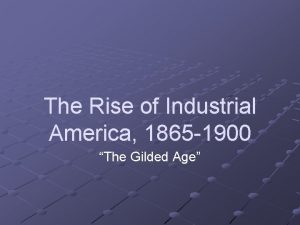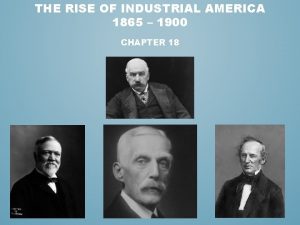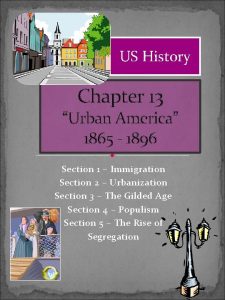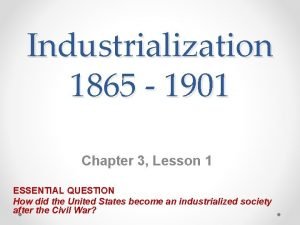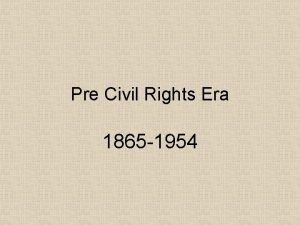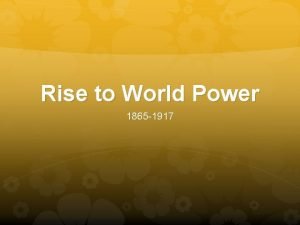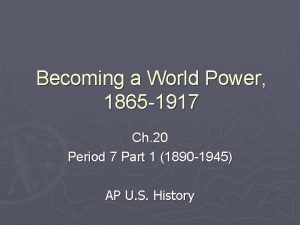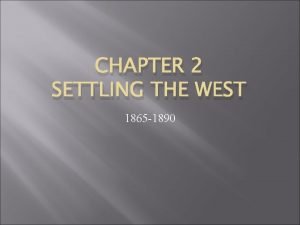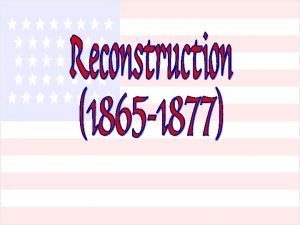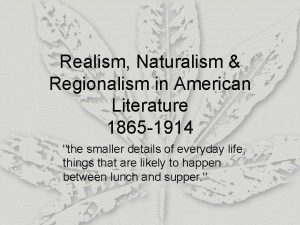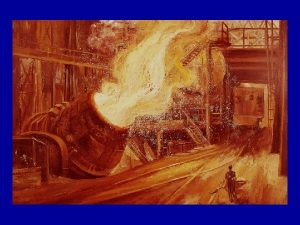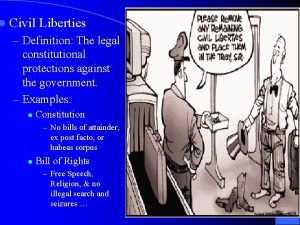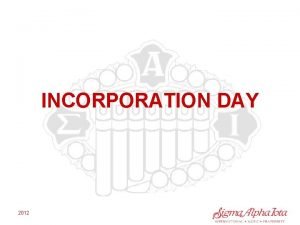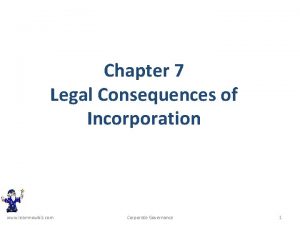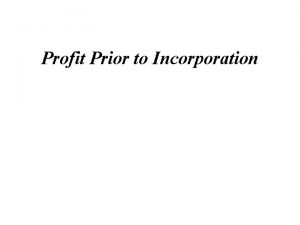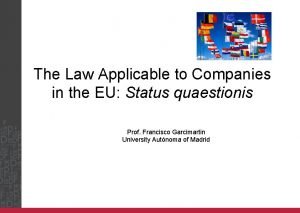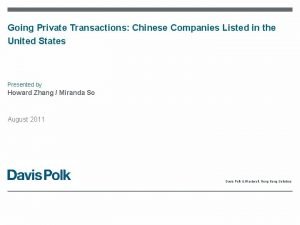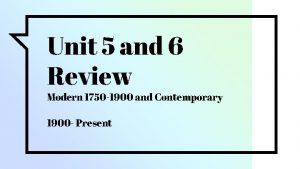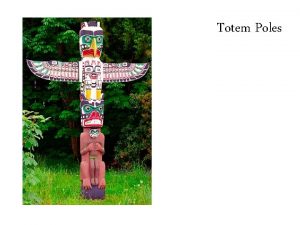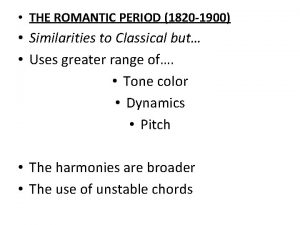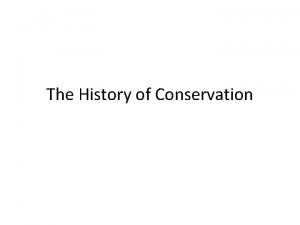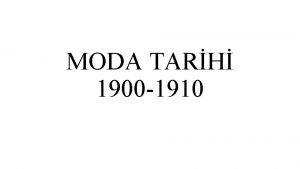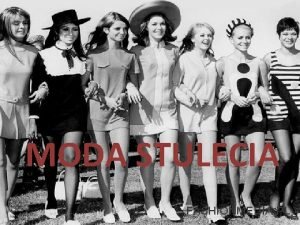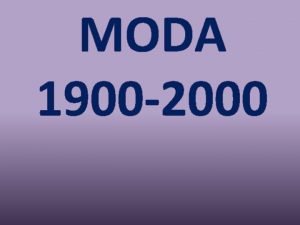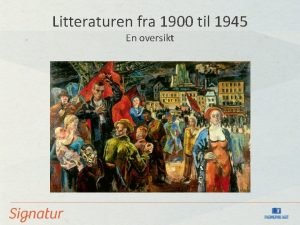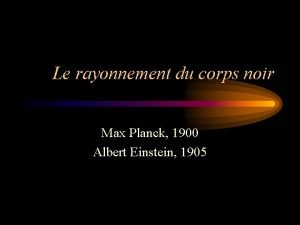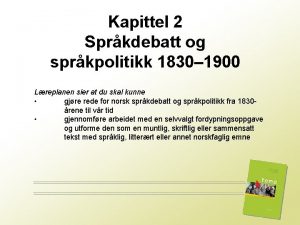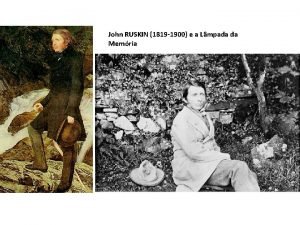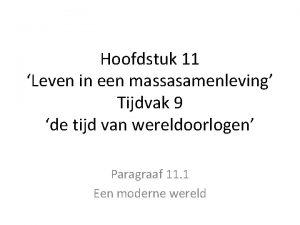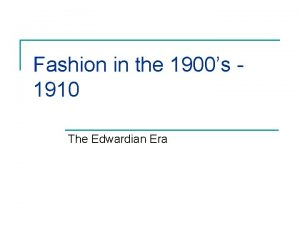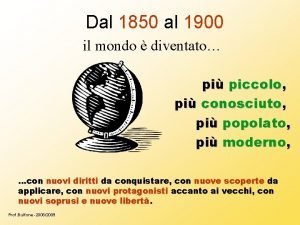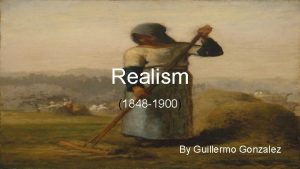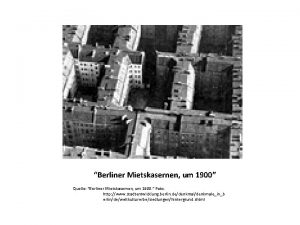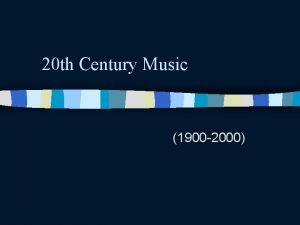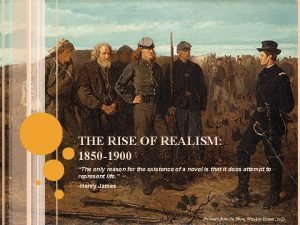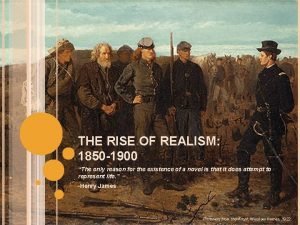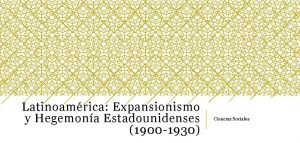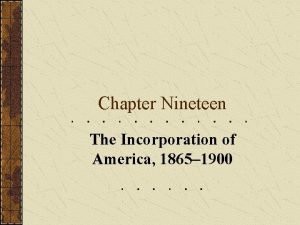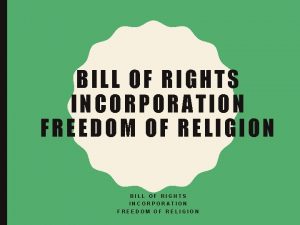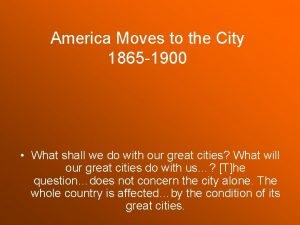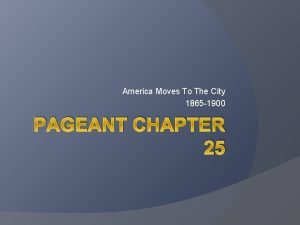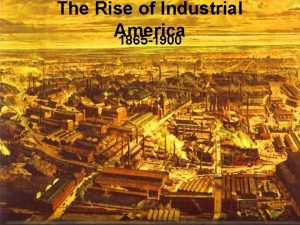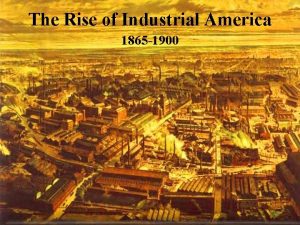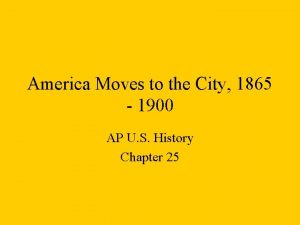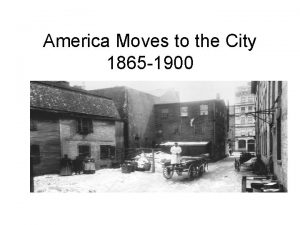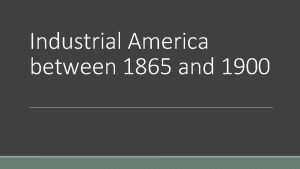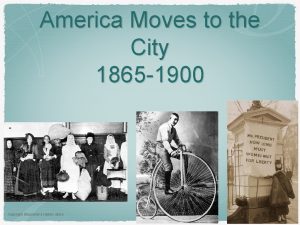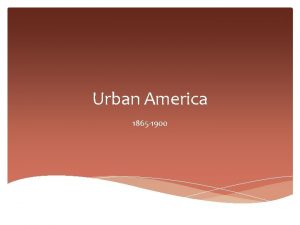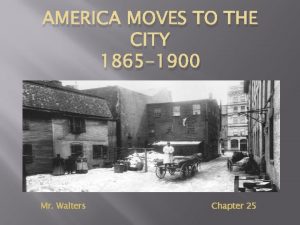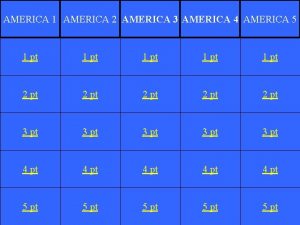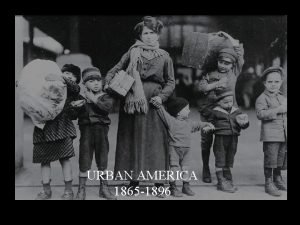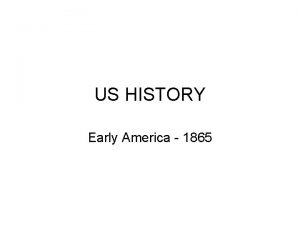Chapter 19 The Incorporation of America 1865 1900

































































- Slides: 65

Chapter 19 The Incorporation of America, 1865 -1900

n n n THE RISE OF INDUSTRY, THE TRIUMPH OF BUSINESS -The post-Civil War era saw a tremendous boom in business and technology. -Inventors like Alexander Graham Bell and Thomas Edison brought new products to Americans. thomas edison -By 1900, Americans had produced over 4, 000 cars. -In 1903, the Wright Brothers pioneered airplane flight.




n n n -Railroads stimulated development as they crisscrossed the nation creating a national market. -Industry grew at a pace previously unimaginable. -By the early 20 th century the United States produced 1/3 of the world’s industrial goods. Continuous machine production characterized many industries. -Coal provided the energy for this “second industrial revolution”.


n n New technologies - Increased productivity of labor and the volume of goods. Assembly line production: -Began with meat-packing -Spread throughout American industry. Talking Edison Doll assembly line, 1890

Meat “Dis”assembly Line!

n n New techniques for marketing and merchandising: -Emerged to distribute the growing volume of goods. Rural free delivery enabled Sears and Montgomery Wards to thrive and required that these companies set up sophisticated ways of reaching their customers. (Before this, people in remote areas had to travel to far away post offices to pick up mail themselves or pay a private courier to bring it to them)

n

624 pages, 25000 items


1894 Montgomery Ward

Department stores and chain stores emerged in the urban market. A busy department store of the 1890 s

1910 Chicago Marshall Fields

n n n n Business leaders: -Tried to gain control over their markets and enlarge their own businesses. -Employed vertical integration to control every step of production. -Employed horizontal combination to gain control of the market for a single product. Periodic depressions: -Wiped out weaker competitors -Enabled the survivors to grow

n n John D. Rockefeller’s Standard Oil Trust: -The best example of horizontal combination. -Congress claimed to have outlawed the trust in 1890, but the enforcement of the law hurt unionization and it did not really prevent the continued consolidation of American business. Rockefeller, monopoly

n n n American business leaders: -Saw their success as an indication of their own personal virtues. -A “gospel of wealth” seemed to justify ruthless financial maneuvering by men like Jay Gould.

n n n Andrew Carnegie, a self-made multi-millionaire, who brought efficiency to the steel industry. Rags to Riches, the-american-dream Carnegie came up with the idea of the “Gospel of Wealth. ” According to this way of thinking, it was God’s will for a few well-suited men to become extremely wealthy. They were the like “trustees” of society’s wealth and they had the responsibility to redistribute this wealth back to society. Carnegie gave away millions (“philanthropist. ”) He favored a “hand up, ” instead of a “hand out” as the best way to improve society. This means rather than giving money to poor, starving individuals, he built libraries, schools, and concert halls.


Carnegie Hall

n n Some ruthless millionaires, like Jay Gould, used the “Gospel of Wealth” to justify their situation. (If I am able to get filthy rich, it must be because God favors me to do so. ) Some people viewed these men as “Captains of industry”: Or are they “Robber Barons? ” Entrepreneurs

n n “Social Darwinism” became a common way of thinking: Applying the concept of “Survival of the Fittest” to explain what was happening in society. Used to justify the fact that some were very wealthy and others were extremely poor

n n The labor force in the late 19 th century underwent a dramatic change as the number of Americans working for wages dramatically grew. -Immigrants met the demands of new industries.

n -Women workers moved into clerical positions created by the advent of the typewriter and telephone, and into retail as sales people.

Chinese Exclusion Act - 1882 n n n -Racism kept African Americans and Chinese out of most skilled positions. Thousands of Chinese immigrants (mostly single, young men) were drawn to the US by the Gold Rush and contract labor for the building of the Railroads When these opportunities slowed, they competed with whites for jobs and there was a racist backlash against them

n n This law suspended Chinese immigration, limited civil rights of current Chinese residents, and forbid their naturalization Initially a 10 -year law, but made permanent in 1902 and not repealed until 1943 (when they were our ally against Japan in WWII)

n n n Factory work: - Was dangerous and tedious -Ten to twelve-hour stint. Periodic depressions threw millions of workers out of jobs. Workers: Mobilized to challenge unsatisfactory working conditions and the wage system that made them possible.

n n n The Knights of Labor: -Led by Terence V. Powderly -Tried, with some success, to organize labor to take control of their own industries -Urged workplace cooperation as the alternative to the wage system. -Set up small cooperatives in various industries, but they generally proved unsuccessful. -Joined the fight for an 8 -hour workday.

n -Workers who were normally excluded from craft unions were allowed to join the Knights, including: unskilled workers, women, and African Americans.


n n n Success of the Knights: -Achieved some gains -But, the Knights lost their crusade for an 8 hour workday due to a violent incident at Chicago’s Haymarket Square. -Employers pooled resources to rid their factories of union organizers. -Basically, the Knights lost and the wage system won.


The American Federation of Labor (AFL): n -Led by Samuel Gompers, n -Organized skilled workers within the wage system. n -Did not organize unskilled workers, females, or racial and ethnic minorities. n -Focused on short-term goals: wages, shorter hours and collective bargaining. n -Unlike other unions, the AFL did achieve a degree of respectability Crash Course n Complete “Philosophy of Industrialists” in Skills Packet for next class n

THE INDUSTRIAL CITY n -In the years after the Civil War, manufacturing moved from rural areas to the city. n -Millions of people followed these jobs to American cities making the United States an urban nation. -Many came from rural areas in the United States n -But immigrants and their children accounted for most of the urban population growth. n

Immigrants: n -Came because of economic opportunities. n -Some returned to their home countries. (Leaving Europe to escape persecution, Jews could not return). Many were from Southern or Eastern Europe in this wave. n -Success depended on the skills the immigrants brought with them. n -Groups tended to live near their countrymen and to work in similar trades. n -Newcomers frequently moved in search of better opportunities. n

1890 Polish immigrants, 1890

n n n The City: -Was transformed under pressure of this huge influx. -Open space rapidly decreased. The gap between living standards of the wealthy and the poor continued to grow -Poor people were packed into tenements in working-class neighborhoods.

"Five Cents a Spot, " Jacob Riis

n n n Wealthy neighborhoods gleamed with new mansions, townhouses, and brownstones. --Streetcars and subways also altered the spatial design of cities. -The extension of transportation allowed residential suburbs to emerge on the edges of the cities.

n n n -Despite technological innovations, pollution continued to be an unsolved problem. -Overcrowding and inadequate sanitation bred a variety of diseases. -Attempts to clean up city water supplies and eliminate waste often led to polluting rivers, building sewage treatment plants, and creating garbage dumps on nearby rural lands. jacob riis

n n CULTURE AND SOCIETY IN THE GILDED AGE The growth of consumer goods and services led to sweeping changes in American behavior and beliefs.

n n The Upper Classes : -Built common networks among themselves. -Created a style of “conspicuous consumption” that broadcast their tremendous wealth to all. -Patronized the arts by funding the galleries and symphonies of their cities.

Dinner with the Vanderbilts

Dinner on horseback at Sherry's Restaurant - New York, 1903 Museum of the City of New York

n n n The expanding “Middle Class”: -Developed its own sense of “proper culture”. -Aided by expanding transit systems, they moved into suburbs providing both space and privacy, but also a long commute to and from work. -Middle-class women devoted their time to housework. -New technologies simplified the tasks, but household work expanded to fill the time available.

-The middle class embraced “culture” and physical exercise for self-improvement and “moral uplift”. n -Not forced to work or perform chores, middle-class youth found leisure a special aspect of their childhood. n



The Working Class: n -Felt disenchanted in the strange and commercial society. n -To deal with the stress, they established close-knit ethnic communities. n -While Chinese, Mexicans, and African Americans often were prevented from living outside of certain neighborhoods, European ethnic groups chose to live in closely-knit communities. n

Many immigrants came without families and lived in boarding houses. n -For many immigrant families, home became a second workplace where the whole family engaged in productive labor. n -Despite their lack of resources, many attempted to imitate middle-class customs of dress and consumption, while preserving Old World customs. n

In New York, officials investigate a squalid tenement, 1900

n n -Immigrant cultures mixed with indigenous cultures to shape the emerging popular cultures of urban America: for example, promoters found that young people were attracted to ragtime and other African. American music. -Amusement parks could attract a mass audience looking for wholesome fun.

Coney Island, 1890 s

Ragtime dance Google Video Scott Joplin, King of Ragtime

n n Education: -Encouraged by business and civic leaders, and the idea of universal free schooling, America’s school system grew rapidly at all levels. Still, only a small minority attended high school or college. -Supported by federal land grants, state universities and colleges grew and developed their modern form, as did the elite liberal arts and professional schools. -Professional education (preparing for specific careers) was an important growth

n n Women began having greater access to colleges. -Vocational (for trades) education also experienced substantial expansion.

n n n Barred from the mainstream, African Americans founded their own colleges and vocational schools. -Howard University, established for African Americans, had its own medical school. -Educator Booker T. Washington founded the Tuskegee Institute to encourage African Americans to concentrate on industrial education.

n n The Gilded Age was an era of Class conflicts: -Disputes over alcohol illustrated the conflict between the working and middle classes -But, both classes found common ground in a growing number of pastimes: Ragtime, vaudeville, and sports brought the two classes together in shared activities that helped to provide a national identity.

Baseball: n -Emerged after the Civil War as the “national pastime” n -Professional teams and league play stimulated fan interest. n -The game initially reflected its working-class fans, both in style of play and in organization, but it soon became tied to the business economy. n


-By the 1880 s baseball had become segregated, leading to the creation of the Negro Leagues in the 1920 s. n -Efforts by players to form their own “cooperative rule league” failed. n

By the Way: The South was a bit different… n n While the West was being “won” and the North was industrializing at a rapid pace, the South was trying to recover from the devastation of the Civil War. Some southerners promoted a vision of an independent southern economy, built on modern capitalism, industry and better transportation Henry Grady, an editor, coined the phrase “New South” to promote this vision, arguing for economic diversity and laissez-faire economics Those promoting the New South hoped to attract investors with tax exemptions and cheap labor

The New South n n n There were some successes: Birmingham and steel, Memphis and the lumber industry, the Piedmont of GA/SC/NC and textiles. Railroads standardized to link up with the rest of the country and cotton mills flourished. Despite these individual examples of growth, much of the South remained poor and agricultural Many of the large businesses were owned by northerners, looking to take advantage of lower wages (internal colony) There was little support among politicians for broad investment in education and technological skills, which limited the economic opportunities of the region and kept it “behind the times. ” Cotton and sharecropping/tenant farming was still the most common way of life for both blacks and whites Crash Course
 The rise of industrial america 1865-1900
The rise of industrial america 1865-1900 The rise of industrial america 1865-1900
The rise of industrial america 1865-1900 1865 to 1900 inventions
1865 to 1900 inventions Urban america 1865 to 1896
Urban america 1865 to 1896 Industrialization (1865 to 1901 worksheet answers key)
Industrialization (1865 to 1901 worksheet answers key) St helen’s smelting co v tipping (1865)
St helen’s smelting co v tipping (1865) 15 th ammendment
15 th ammendment Becoming a world power 1865-1917
Becoming a world power 1865-1917 Impressionism characteristics
Impressionism characteristics Chapter 20 becoming a world power notes
Chapter 20 becoming a world power notes Settling the west 1865-1890
Settling the west 1865-1890 Gregor mendel 1865
Gregor mendel 1865 Impressionism (1865–1885)
Impressionism (1865–1885) Whats the compromise of 1877
Whats the compromise of 1877 Regionalism literary movement
Regionalism literary movement Industrialization (1865 to 1901 worksheet answers key)
Industrialization (1865 to 1901 worksheet answers key) Selective incorporation definition
Selective incorporation definition Selective incorporation definition
Selective incorporation definition Incorporation day
Incorporation day Learnnowbiz
Learnnowbiz Alice porter murray
Alice porter murray Profit prior to incorporation is
Profit prior to incorporation is Incorporation method of ointment preparation
Incorporation method of ointment preparation Asas place of incorporation
Asas place of incorporation Real seat theory vs incorporation theory
Real seat theory vs incorporation theory Profit prior to incorporation
Profit prior to incorporation What is pre incorporation contracts in company law
What is pre incorporation contracts in company law Procedure for incorporation of company
Procedure for incorporation of company Howard zhang davis polk
Howard zhang davis polk Rap of the states
Rap of the states Asia africa song
Asia africa song Whats an onomatopeia
Whats an onomatopeia Why is latin america called latin america
Why is latin america called latin america Eu amo a américa e a américa me ama
Eu amo a américa e a américa me ama 1750-1900 portfolio map
1750-1900 portfolio map Bumblebee totem pole
Bumblebee totem pole Characteristics of romantic period
Characteristics of romantic period Taylor grazing act 1934
Taylor grazing act 1934 Freud 1900
Freud 1900 Iso 1900
Iso 1900 1820-1900
1820-1900 Revolutionary leaders 1900-1939
Revolutionary leaders 1900-1939 Sanatnedr
Sanatnedr Moda francuska w panu tadeuszu
Moda francuska w panu tadeuszu Moda 2000
Moda 2000 Litteraturen 1900 til 1945
Litteraturen 1900 til 1945 Literatur um die jahrhundertwende
Literatur um die jahrhundertwende 1900 max planck
1900 max planck Språkdebatten 1900
Språkdebatten 1900 Resssucitar
Resssucitar Inf1900
Inf1900 Massasamenleving
Massasamenleving French fashion 1800
French fashion 1800 Edwardian period fashion
Edwardian period fashion Kristallpalast london referat
Kristallpalast london referat Scoperte scientifiche dal 1850 al 1900
Scoperte scientifiche dal 1850 al 1900 Vtbu chart
Vtbu chart Zurn z1920
Zurn z1920 Realism (1848–1900)
Realism (1848–1900) Moda italia clothing
Moda italia clothing Bucuresti 1900
Bucuresti 1900 Mietskasernen um 1900
Mietskasernen um 1900 Renaissancism
Renaissancism Realism 1850 to 1900
Realism 1850 to 1900 Realism 1850 to 1900
Realism 1850 to 1900 El desplazamiento del dominio colonial europeo
El desplazamiento del dominio colonial europeo
